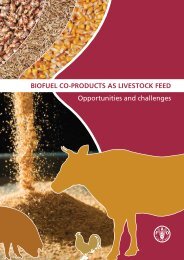Distillers Grains Feeding Recommendations. - Distillers Grains By ...
Distillers Grains Feeding Recommendations. - Distillers Grains By ...
Distillers Grains Feeding Recommendations. - Distillers Grains By ...
Create successful ePaper yourself
Turn your PDF publications into a flip-book with our unique Google optimized e-Paper software.
Distiller Grain Trial Rincker and Berger (2003)Treatments 3 through 6 compared the relative value of WDG and DDG at 25 or 50% of the diet fordairy-beef steers which are important for two reasons. First, it is cheaper and more energy efficient toproduce WDG than DDG. Alcohol producers can then sell WDG for slightly less than DDG on anequal DM basis and still generate the same net revenue from the byproduct stream. At the same time,WDG diets may reduce DMI in cattle if the total moisture level is too high. Farlin (1981)demonstrated that including 64% WDG (DM basis) reduced DMI 11%. With young calves the DMlevel in the diet may have greater effects on intake than with the yearling steers in the Farlin trial. <strong>By</strong>including the WDG and DDG at two levels, we can answer the question whether DDG is morevaluable then WDG at higher inclusion rates. Previous research shows that both WDG and DDG havesimilar nutritional value when fed at low levels in the diet (Firkins et al. 1984). Additionally, thesecomparisons are important in that transporting the water in WDG is expensive. For some plantshaving both DDG and WDG available is the best alternative. WDG could be used by local beef anddairy producers, while those further from the source may find the DDG to be more economical.MATERIALS AND METHODSThree-hundred and fifty Holstein steer calves were purchased and sent to the Beef Research Unit at theUniversity of Illinois in August 2002. The steers were immediately put on a pelleted grain mix andlong-hay diet, ear-tagged, dewormed, and vaccinated according to their available records. The steerswere gradually adjusted to an 85% concentrate-15% corn silage diet by replacing the corn silage withwhole corn. The diets were balanced to meet or exceed the 1996 NRC Nutrient Requirements of BeefCattle. The calves were vaccinated against infectious bovine rhinotracheitis (IBR), parainfluenza,clostridia, malignant edema, Haemophilus somnus, and Pasterurella. The steers were weighed onSeptember 4, 2002 preliminarily and checked for illnesses. Those suffering from shipping fever orpinkeye were treated accordingly.The steers were weighed on September 18 and 19th on two consecutive days. The two initial weightswere averaged to use as a starting weight (420.7 + 71.5 lbs). Electronic Identification (E-IDs) tagswere inserted in all steers. Thirty calves were culled based on health, performance, and weight tocreate the most uniform set to start the trial. Forty pens were randomly assigned to ten treatments witheight calves per pen. The building has an open front, south exposure, with concrete fenceline feedbunks and the pens (12 X 40 feet) were bedded with wood chips. Electric-heated waters wereavailable in each pen and the area was cleaned on a regular basis. The management and healthprocedures were approved by the University of Illinois Department of Animal Resources.Ten dietary treatments that were randomly assigned to 40 different pens. The treatments are based onUniversity of Illinois research and are as described in Table 1. Three different supplements (Table 2)were formulated to proved mineral vitamins and feed additives.The WDG and DDG grains were provided by Archer Daniels Midland (ADM) from their Peoria,Illinois plant. A sample of each dietary treatment along with both the WDG and DDG were sent to acommercial laboratory for analysis.The cattle were weighed at 28-day intervals. At 56 days, the cattle had their horns blunted with aBarnes dehorner and were implanted with Component E-S Steer Implants from VetLife with Tylan3
















